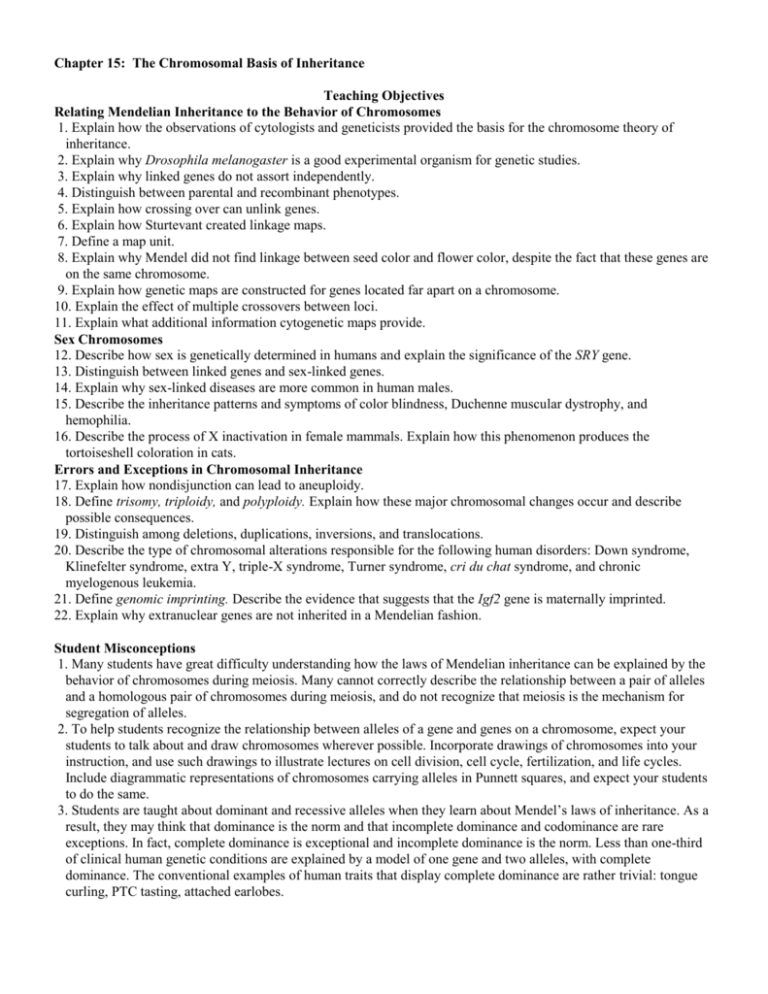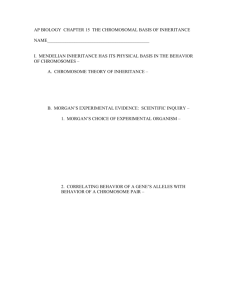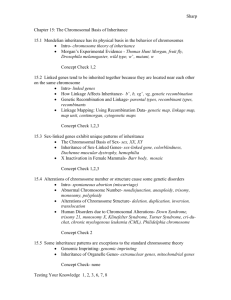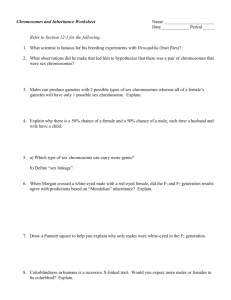Chapter 15: The Chromosomal Basis of Inheritance
advertisement

Chapter 15: The Chromosomal Basis of Inheritance Teaching Objectives Relating Mendelian Inheritance to the Behavior of Chromosomes 1. Explain how the observations of cytologists and geneticists provided the basis for the chromosome theory of inheritance. 2. Explain why Drosophila melanogaster is a good experimental organism for genetic studies. 3. Explain why linked genes do not assort independently. 4. Distinguish between parental and recombinant phenotypes. 5. Explain how crossing over can unlink genes. 6. Explain how Sturtevant created linkage maps. 7. Define a map unit. 8. Explain why Mendel did not find linkage between seed color and flower color, despite the fact that these genes are on the same chromosome. 9. Explain how genetic maps are constructed for genes located far apart on a chromosome. 10. Explain the effect of multiple crossovers between loci. 11. Explain what additional information cytogenetic maps provide. Sex Chromosomes 12. Describe how sex is genetically determined in humans and explain the significance of the SRY gene. 13. Distinguish between linked genes and sex-linked genes. 14. Explain why sex-linked diseases are more common in human males. 15. Describe the inheritance patterns and symptoms of color blindness, Duchenne muscular dystrophy, and hemophilia. 16. Describe the process of X inactivation in female mammals. Explain how this phenomenon produces the tortoiseshell coloration in cats. Errors and Exceptions in Chromosomal Inheritance 17. Explain how nondisjunction can lead to aneuploidy. 18. Define trisomy, triploidy, and polyploidy. Explain how these major chromosomal changes occur and describe possible consequences. 19. Distinguish among deletions, duplications, inversions, and translocations. 20. Describe the type of chromosomal alterations responsible for the following human disorders: Down syndrome, Klinefelter syndrome, extra Y, triple-X syndrome, Turner syndrome, cri du chat syndrome, and chronic myelogenous leukemia. 21. Define genomic imprinting. Describe the evidence that suggests that the Igf2 gene is maternally imprinted. 22. Explain why extranuclear genes are not inherited in a Mendelian fashion. Student Misconceptions 1. Many students have great difficulty understanding how the laws of Mendelian inheritance can be explained by the behavior of chromosomes during meiosis. Many cannot correctly describe the relationship between a pair of alleles and a homologous pair of chromosomes during meiosis, and do not recognize that meiosis is the mechanism for segregation of alleles. 2. To help students recognize the relationship between alleles of a gene and genes on a chromosome, expect your students to talk about and draw chromosomes wherever possible. Incorporate drawings of chromosomes into your instruction, and use such drawings to illustrate lectures on cell division, cell cycle, fertilization, and life cycles. Include diagrammatic representations of chromosomes carrying alleles in Punnett squares, and expect your students to do the same. 3. Students are taught about dominant and recessive alleles when they learn about Mendel’s laws of inheritance. As a result, they may think that dominance is the norm and that incomplete dominance and codominance are rare exceptions. In fact, complete dominance is exceptional and incomplete dominance is the norm. Less than one-third of clinical human genetic conditions are explained by a model of one gene and two alleles, with complete dominance. The conventional examples of human traits that display complete dominance are rather trivial: tongue curling, PTC tasting, attached earlobes. Key Terms aneuploidy Barr body chromosome theory of inheritance crossing over cytogenetic map deletion Down syndrome Duchenne muscular dystrophy duplication genetic map genetic recombination genomic imprinting hemophilia inversion linkage map linked genes map unit monosomic nondisjunction parental type polyploidy recombinant sex-linked gene translocation trisomic wild type Word Roots aneu- 5 without (aneuploidy: a chromosomal aberration in which certain chromosomes are present in extra copies or are deficient in number) cyto- 5 cell (cytological maps: charts of chromosomes that locate genes with respect to chromosomal features) hemo- 5 blood (hemophilia: a human genetic disease caused by a sex-linked recessive allele, characterized by excessive bleeding following injury) mono- 5 one (monosomic: a chromosomal condition in which a particular cell has only one copy of a chromosome, instead of the normal two; the cell is said to be monosomic for that chromosome) non- 5 not; dis- 5 separate (nondisjunction: an accident of meiosis or mitosis, in which both members of a pair of homologous chromosomes or both sister chromatids fail to move apart properly) poly- 5 many (polyploidy: a chromosomal alteration in which the organism possesses more than two complete chromosome sets) re- 5 again; com- 5 together; -bin 5 two at a time (recombinant: an offspring whose phenotype differs from that of the parents) trans- 5 across (translocation: attachment of a chromosomal fragment to a nonhomologous chromosome) tri- 5 three; soma- 5 body (trisomic: a chromosomal condition in which a particular cell has an extra copy of one chromosome, instead of the normal two; the cell is said to be trisomic for that chromosome) Instructor’s Guide for Campbell/Reece Biology, Seventh Edition








